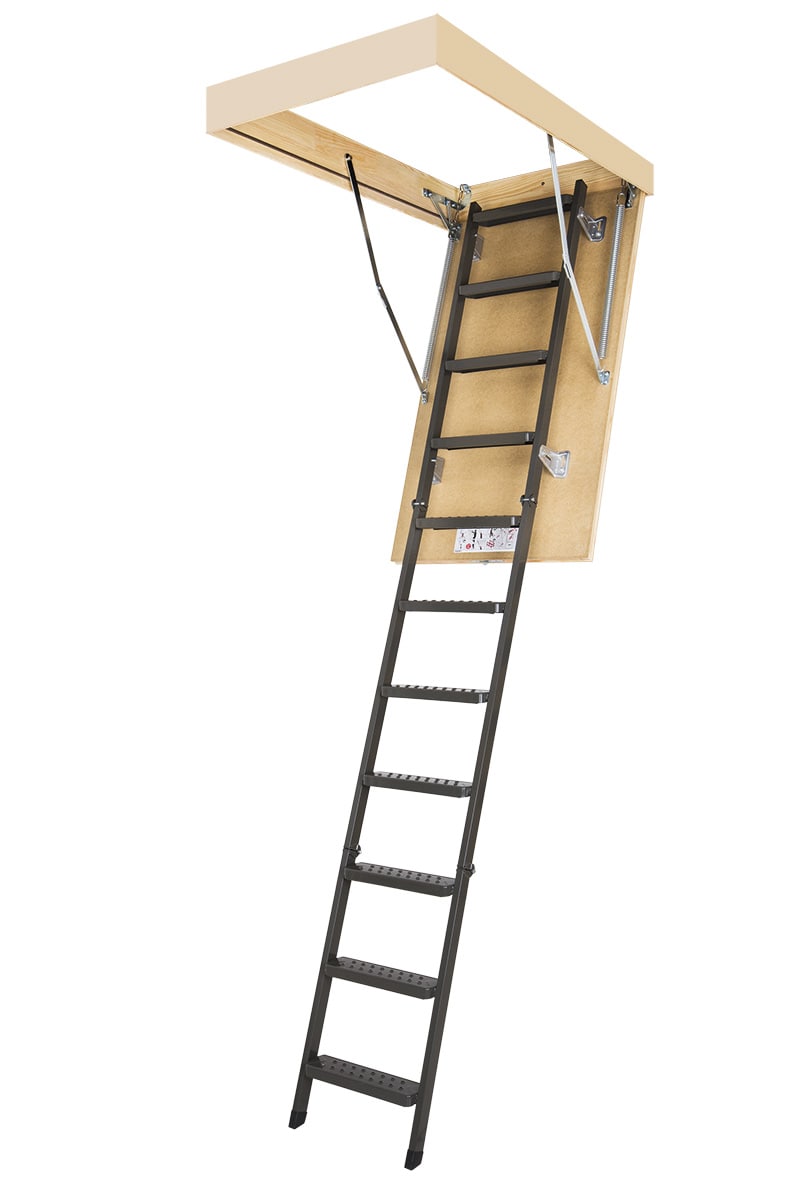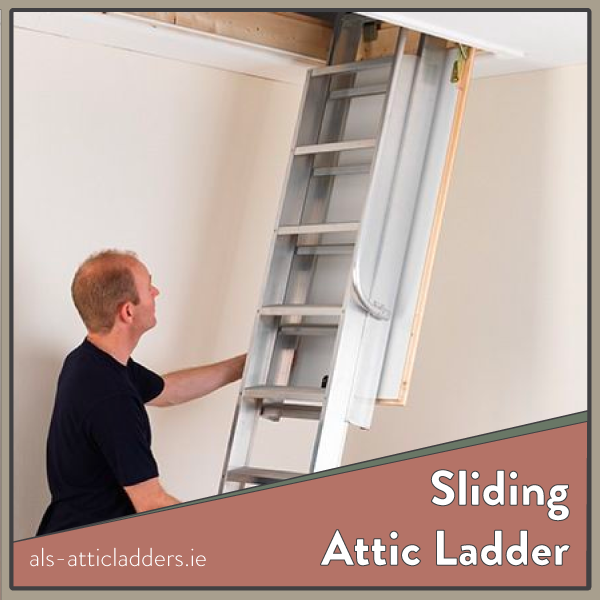Attic ladders provide easy access to your attic space. They are practical and save space.
But how do they work? Attic ladders are designed for convenience and safety. They fold up and store in the attic when not in use. When you need to access the attic, you simply unfold the ladder. The ladder is often attached to a frame that is fixed to the attic opening.
This frame ensures stability and security as you climb. Attic ladders come in various materials, such as wood or metal, and different designs, like telescoping or folding. Understanding how attic ladders work can help you choose the right one for your home. Let’s explore the mechanics and features of these useful tools.
Introduction To Attic Ladders
Attic ladders are foldable ladders that provide access to the attic space in your home. They are a practical solution for reaching storage areas that are otherwise hard to access. These ladders are often installed in the ceiling of a hallway or closet, making them convenient and space-saving.
Purpose And Benefits
The primary purpose of an attic ladder is to offer safe and easy access to your attic. Attic ladders provide several benefits, including:
- Space Efficiency: They fold away when not in use, saving space.
- Convenience: No need for a separate step ladder.
- Safety: Designed to be sturdy and reliable.
- Easy Installation: Can be installed without professional help.
- Cost-Effective: Affordable way to add functionality to your home.
Types Of Attic Ladders
There are various types of attic ladders, each suited for different needs and preferences. Here are the most common types:
| Type | Material | Features |
|---|---|---|
| Wooden Attic Ladders | Wood | Sturdy, traditional, often has a higher weight capacity. |
| Aluminum Attic Ladders | Aluminum | Lightweight, rust-resistant, easy to install. |
| Telescoping Attic Ladders | Aluminum or Steel | Compact, extends to the needed length, good for tight spaces. |
| Sliding Attic Ladders | Aluminum or Steel | Slides in and out, saves space, easy to use. |
Choosing the right attic ladder involves considering factors like the height of your ceiling, the space available for the ladder, and your budget. Wooden attic ladders are great for heavy-duty use, while aluminum ladders offer a lightweight, easy-to-handle option.

Credit: diy.stackexchange.com
Choosing The Right Attic Ladder
Choosing the right attic ladder can seem overwhelming. There are many factors to consider. This guide will help you make an informed decision. We will cover material options and size and weight considerations.
Material Options
Attic ladders come in different materials. The most common are wood, aluminum, and steel. Each material has its benefits and drawbacks.
- Wood: Wood ladders are sturdy and provide a classic look. They are often heavier and require more maintenance.
- Aluminum: Aluminum ladders are lightweight and resistant to rust. They are easy to handle but may not be as strong as steel.
- Steel: Steel ladders are very strong and durable. They are heavier and may be harder to install.
Size And Weight Considerations
The size and weight of the attic ladder are crucial. You need to measure the height from the floor to the ceiling. Also, consider the opening size of the attic access.
| Measurement | Details |
|---|---|
| Floor to Ceiling Height: | Measure from the floor to the ceiling where the ladder will be installed. |
| Attic Opening Size: | Measure the width and length of the attic opening. |
Consider the weight capacity of the ladder. Ensure it can support your weight and any items you carry. Most ladders have a weight limit between 200 to 375 pounds.
Choose a ladder that fits your attic space. It should be easy to use and safe. Proper measurements and weight considerations ensure a good fit.
Preparing For Installation
Before you start installing an attic ladder, preparation is key. A smooth and safe installation requires the right tools and safety measures. Let’s break down what you need to do before you begin.
Tools Needed
- Measuring tape
- Drill
- Screwdriver
- Hammer
- Level
- Saw
- Wrench
- Safety glasses
Having these tools ready will make the process easier and faster. Keep them within reach to avoid delays.
Safety Precautions
Safety should be your top priority. Follow these precautions to ensure a safe installation:
- Wear safety glasses: Protect your eyes from dust and debris.
- Use a sturdy ladder: Ensure your ladder is stable and in good condition.
- Clear the area: Remove any obstacles from your workspace.
- Work with a partner: Having someone to assist can prevent accidents.
- Check for wiring: Be cautious of electrical wires in your attic space.
- Follow instructions: Carefully read and adhere to the manufacturer’s guidelines.
By taking these steps, you can minimize risks and complete the installation safely.

Credit: www.fakro.co.uk
Installing The Attic Ladder
Installing an attic ladder may seem like a daunting task, but it can be manageable with the right tools and steps. This section will guide you through the process, ensuring you have a safe and functional attic ladder.
Measuring And Marking
Before you start, gather all necessary tools. You’ll need a tape measure, pencil, and a level. Begin by measuring the ceiling opening where the ladder will be installed. Ensure that the space is large enough for the ladder’s frame.
Next, mark the center point of the opening on the ceiling. Use your tape measure to find the exact center. Mark the outline of the ladder’s frame on the ceiling using a pencil. Ensure your marks are straight and level.
Cutting And Framing
Once your markings are in place, it’s time to cut the ceiling. Use a saw to carefully cut along the marked lines. Be sure to wear safety goggles and a mask during this step to protect yourself from dust and debris.
After cutting the opening, you need to frame it. Use sturdy lumber to create a frame that matches the dimensions of the ladder. Secure the frame with nails or screws, ensuring it is level and well-supported. This frame will provide a strong base for the attic ladder.
Here’s a simple table to summarize the steps:
| Step | Description |
|---|---|
| 1 | Measure the opening |
| 2 | Mark the center point |
| 3 | Outline the ladder frame |
| 4 | Cut the ceiling |
| 5 | Frame the opening |
By following these steps, you ensure a secure and stable installation for your attic ladder. This makes accessing your attic safe and easy.
Securing And Testing
Installing an attic ladder can enhance your home’s functionality. Understanding how to secure and test the ladder ensures safety. This section covers the necessary steps to attach and test the attic ladder for stability.
Attaching The Ladder
Properly attaching the attic ladder is crucial. Begin by aligning the ladder with the attic opening. Ensure it fits snugly and securely in place. Use heavy-duty screws to attach the ladder to the frame. This will provide a strong foundation. Follow the manufacturer’s instructions for the exact placement of screws. Typically, you will need to secure each corner and the middle points.
| Step | Description |
|---|---|
| 1 | Align the ladder with the attic opening. |
| 2 | Ensure the ladder fits snugly in the opening. |
| 3 | Attach the ladder using heavy-duty screws. |
| 4 | Secure each corner and middle points. |
Testing For Stability
After attaching the ladder, the next step is testing for stability. Open the ladder and extend it fully. Check that each step is secure and doesn’t wobble. Gently apply weight to the ladder to test its strength. If the ladder shifts, re-secure the screws and test again.
- Open and extend the ladder fully.
- Check each step for wobbling.
- Apply gentle weight to test strength.
- Re-secure if the ladder shifts.
Repeat these tests until the ladder remains stable. Ensuring the ladder is secure and stable will prevent accidents. Proper testing is essential for safety.
Maintenance And Safety Tips
Attic ladders are a great way to access extra storage space. To ensure they work well, you need to maintain and use them properly. Here are some tips to help you keep your attic ladder in top shape.
Regular Inspections
Regular inspections are key to attic ladder safety. Check your ladder at least twice a year. Look for any signs of wear and tear. Make sure all screws and bolts are tight. If you find any loose parts, tighten them right away.
| Inspection Point | What to Look For |
|---|---|
| Hinges | Rust or stiffness |
| Steps | Cracks or bends |
| Frame | Loose screws or bolts |
Proper Usage Techniques
Using the attic ladder properly can prevent accidents. Always make sure the ladder is fully extended before climbing. Never skip any steps. Always face the ladder while climbing.
- Do not carry heavy items while climbing.
- Keep three points of contact on the ladder.
- Ensure the ladder is dry and free of grease.
By following these tips, you can ensure your attic ladder remains safe and functional. Regular maintenance and proper usage are essential for longevity and safety.

Credit: als-atticladders.ie
Frequently Asked Questions
What Is An Attic Ladder?
An attic ladder is a foldable ladder installed in ceilings. It provides access to the attic.
How Do You Install An Attic Ladder?
To install an attic ladder, secure the frame to the ceiling opening. Then, attach the ladder to the frame.
Are Attic Ladders Safe?
Yes, attic ladders are safe when installed correctly. Always follow the manufacturer’s instructions.
What Materials Are Attic Ladders Made From?
Attic ladders are usually made from wood, aluminum, or steel. Each material has its own advantages.
How Do I Maintain An Attic Ladder?
Check for loose screws and parts regularly. Lubricate hinges and joints to ensure smooth operation.
Conclusion
Attic ladders make accessing your attic space easy and convenient. They fold up neatly, saving space when not in use. Installation is straightforward, with most models fitting standard openings. Safety features, like slip-resistant steps, ensure secure footing. Regular maintenance keeps the ladder in good working condition.
Choose a ladder that fits your needs and home layout. With proper care, an attic ladder can last many years, providing easy access to storage or additional space. Always follow the manufacturer’s guidelines for the best results. Enjoy your new, easy-to-reach attic space!
Recent Posts
Maintaining clean gutters is essential for preventing water damage to your home, and choosing the best ladder for cleaning gutters can make the job much easier and safer. With so many options on the...
Best Ladder for Cleaning Caravan Roof: Top Picks for You Every Adventure!
Today we will discuss the best ladder for cleaning caravan roof. Cleaning caravan roofs is one of the crucial tasks.After many days, a caravan roof can get dirty by debris, dirt, and grime. These can...
